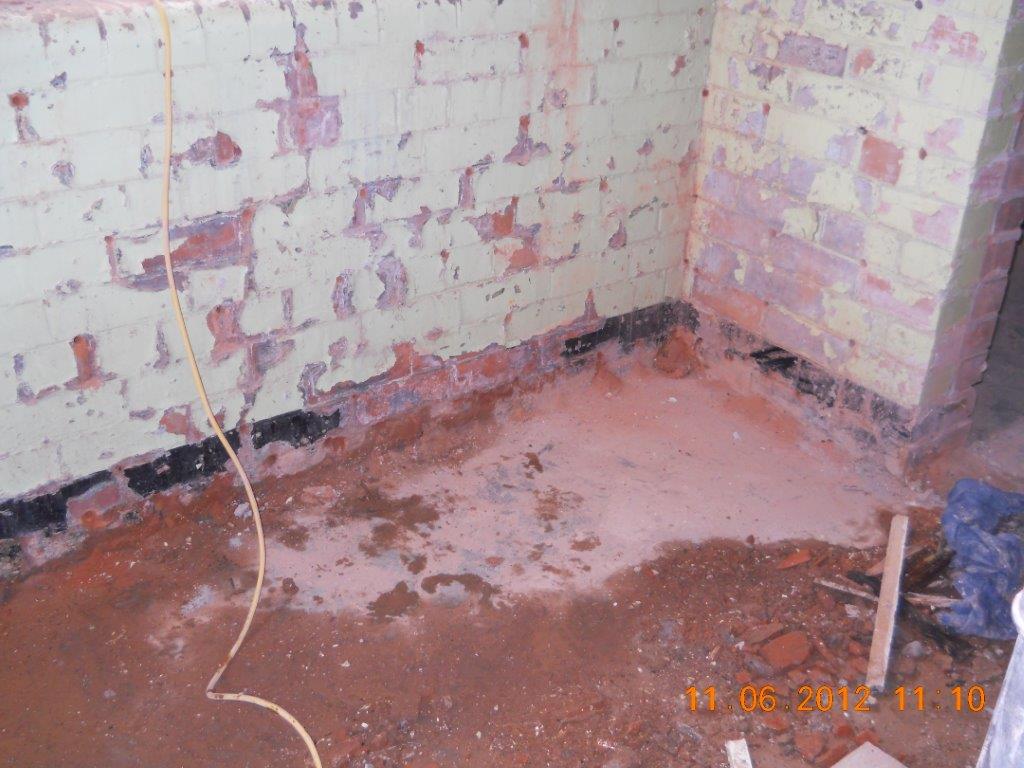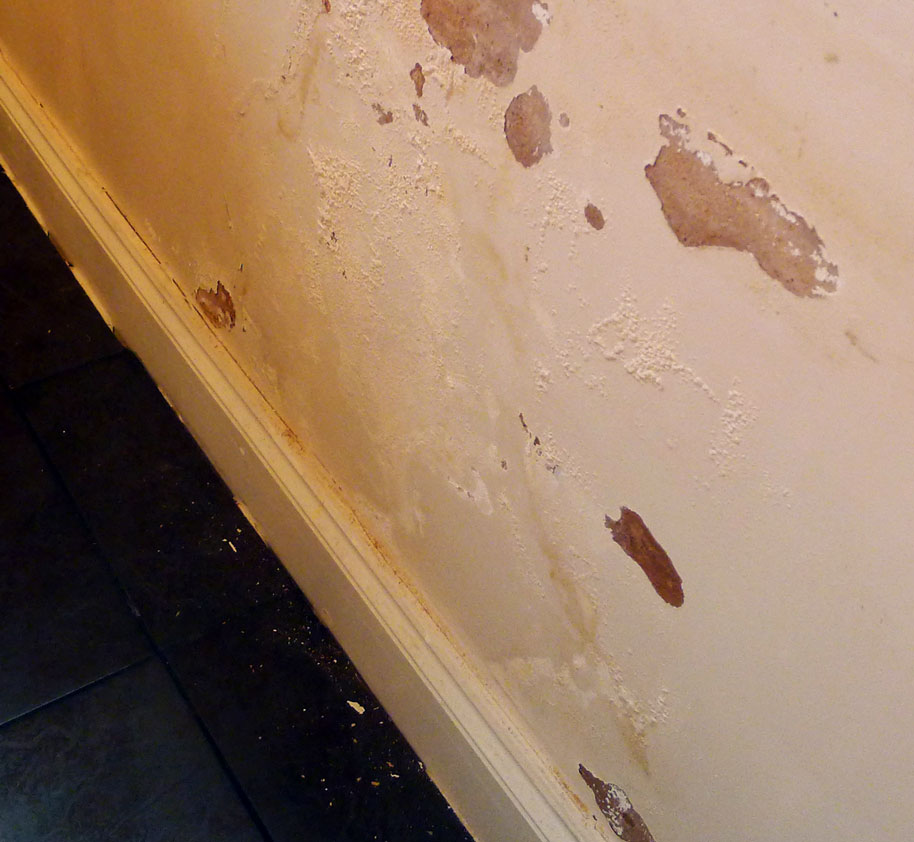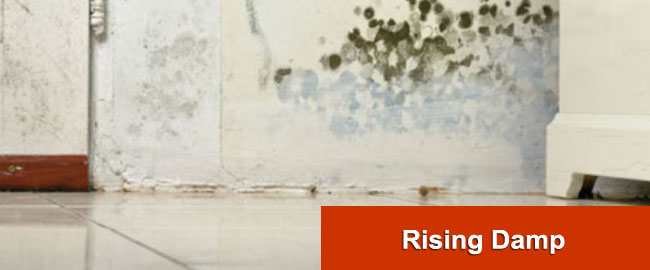Injection of a liquid or cream into bricks or mortar is the most common technique of treating rising damp. Modifications to a constructing involving impermeable supplies can also exacerbate the signs of rain penetration by trapping moisture. This is usually a explicit problem with regard to the set up of retrofit exterior wall insulation (EWI). describes a number of methods of treating rising damp, including the use of land-drains and the insertion of physical and chemical DPCs. Then, any affected plaster or mortar should be removed, and the wall handled, before changing the plaster and repainting.
The theoretical capillary rise is an impressive 14 metres! In follow, because of this moisture can stand up from underground via the foundations and seep up the partitions. Damp (basement) areas, plaster damage and masonry defects are the implications. Rising damp may be brought on by quite a lot of components such as the failure of an existing damp proofing course (DPC) or what is termed ‘bridging’ of that DPC as a result of different ranges of the floor on the inside and outdoors of the property which may cause the damp proofing course to fail. You may find that older buildings have by no means had a humid proofing course in any respect.
The salt crystals grow bigger than the pores can take care of and this ends in flaking renders. Rising damp could be seen inside and outside, excessive up on partitions at connection factors and at foundations, and on totally different substrates. To take care of this problem, a good drainage system and waterproofing is critical.
This technique can provide an extremely efficient barrier to rising damp, but isn't broadly used as it requires experienced contractors to hold out if structural motion is to be prevented and takes significantly longer to put in than different kinds of rising damp remedy. The value is also a number of occasions higher than for other types of rising damp treatment. Most types of dampness can be prevented by thoughtful building design and cautious development. In the UK, nicely constructed modern homes include damp proofing within the form of a synthetic damp-proof course (DPC), about 15Â cm above ground stage, to behave as a barrier through which water can not cross.
They are leaking and there may be rising damp because of defective damp-proof programs. never seen a real case of rising damp in a British home.
The impact can easily be seen by simply inserting a chunk of porous brick, stone, or mortar in a shallow tray of water and observing how the water is absorbed into the porous material and is transported above the water line. Condensation comes from water vapour throughout the constructing. Common sources could embrace cooking, bathing, dishwashers, and so on. The moisture within the air condenses on cold surfaces, sometimes inside the partitions known as interstitial condensation.
Our technical article describes this. Rising damp is just water from the ground that rises by way of the bricks of a wall. It is most frequently caused by a breakdown of an outdated damp proof course, or the lack of one altogether. It can happen on any wall (internal or external) that's build into the ground on a foundation.
However, the deficiencies of any remedial damp-proof course shall be more apparent if the wall isn't coated with a water-resistant render. For this reason you will need to verify the BBA certificate of the damp-proofing system to ensure that it's valid to be used the place replastering isn't being carried out. Creams are applied at much decrease application charges than is typical for fluid injection and are designed to unfold by way of masonry by diffusion without the help of pressure injection. Owing to the number of completely different mortar sorts and moisture contents, it is needed to test these materials underneath a wider range of circumstances. Research undertaken by the BBA has indicated that the efficiency of lotions differs with various test circumstances, with not all merchandise performing nicely beneath all take a look at circumstances.
Details of potential remedies for specific kinds of dampness are covered in the sections below. requires that buildings should be constructed to withstand rising damp, penetrating damp, and condensation. Structural dampness is the presence of undesirable moisture in the structure of a building, both the results of intrusion from outdoors or condensation from throughout the structure. Alan Moore did not appear in the final series (Series 4) of Rising Damp, Richard Beckinsale being busy with different appearing work. Specialists in Damp Proofing, Structural Water Proofing, Condensation Control & Plastering in London and surrounding areas.
For instance, a flower bed next to an affected wall would possibly result in soil being piled up towards the wall above the extent of the DPC. In this instance, moisture from the ground would be capable of ingress via the wall from the soil. Such a humid downside might be rectified by simply decreasing the flower bed to below DPC level. The competence and experience of the person endeavor the damp investigations is often of larger significance than the package she or he carries.

Prevention and therapy
 .gbip::beforecontent:url(https://ssl.gstatic.com/gb/images/silhouette_96.png)@media (min-resolution:1.25dppx),(-o-min-device-pixel-ratio:5/4),(-webkit-min-device-pixel-ratio:1.25),(min-device-pixel-ratio:1.25){.gbii::beforecontent:url(https://ssl.gstatic.com/gb/images/silhouette_27.png).gbip::before
.gbip::beforecontent:url(https://ssl.gstatic.com/gb/images/silhouette_96.png)@media (min-resolution:1.25dppx),(-o-min-device-pixel-ratio:5/4),(-webkit-min-device-pixel-ratio:1.25),(min-device-pixel-ratio:1.25){.gbii::beforecontent:url(https://ssl.gstatic.com/gb/images/silhouette_27.png).gbip::before
Wall coverings, render/plaster and so forth. might be eliminated to expose masonry or brick work. Capillaries are tubes or elongated cavities with a very small internal diameter. Due to the effects of physics, water is in a position to withstand the pull of gravity and stand up inside these cavities of its own accord.
In a newly-constructed home damp can occur if the water used when the house was built remains to be drying out. Rising damp is unpleasant as well as being unhealthy and infrequently leads to timber decay and lack of warmth out of your property. Rising damp carries hygroscopic salts, which take up moisture from the ambiance, which in flip causes damp in partitions in situations of high humidity which is often the case in lots of homes. The presence of these salts then breaks down inner plaster and leaves residue on inside walls which is impossible to remove with out specialist therapy. We show you the way to deal with damp partitions in an outdated home internally with Dryrod from Safeguard Europe, their latest growth in Rising Damp therapy.
The impact can easily be seen by simply inserting a piece of porous brick, stone, or mortar in a shallow tray of water and observing how the water is absorbed into the porous materials and is transported above the water line. Condensation comes from water vapour throughout the building. Common sources might include cooking, bathing, dishwashers, and so forth. The moisture within the air condenses on cold surfaces, generally contained in the walls called interstitial condensation.
Specialists in Damp Proofing, Rising Damp, Penetrating Damp, Structural Water Proofing, Condensation Control & Plastering in London and surrounding areas. All rubbish and waste materials might be eliminated. Render and/or plaster can then be reinstated leaving your repaired wall area ready for redecoration. The modern methods and materials we use are the best out there within the prevention of rising damp. Our procedures are reliable and proven to succeed, in addition to being safe, odourless and non poisonous.
Our technical article describes this. Rising damp is just water from the ground that rises by way of the bricks of a wall. It is most frequently brought on by a breakdown of an previous damp proof course, or the dearth of one altogether. It can happen on any wall (inside or external) that's construct into the bottom on a foundation.
It has been advised that improving drainage round partitions affected by rising damp might help to scale back the peak of rise by decreasing the amount of water out there to be absorbed into the capillaries of the wall. Typically a trench would be excavated across the affected wall into which a porous pipe would be laid. The trench would then be back-crammed with a porous materials corresponding to a single-sized mixture, forming a French drain. In simple terms rising damp happens when floor water travels upwards via porous constructing materials corresponding to brick, sandstone, or mortar, much in the identical way that oil travels upwards via the wick of a lamp.
Trotman, Peter. Rising damp in partitions, prognosis and remedy. BRE Digest 245.
Is damp lined by insurance?
Another methodology is to bodily cut and insert a steel sheet a number of centimetres above floor. This might stop the capillary rise in the render, but not if the capillary rise can also be taking place inside the masonry. Please contact your local organisation to get an outline of strategies utilized in your area and best suited to your venture.
Experience and qualified surveyors are the distinction between an accurate and incorrect prognosis of damp. For instance, it's sometimes found that condensation is misdiagnosed as one other type of dampness ensuing within the incorrect form of treatment being specified. Chartered constructing surveyors are normally experienced in identifying dampness issues, nevertheless, their reviews typically suggest that dampness problems are investigated by a specialist damp and timber surveyor with a CSRT qualification. If there may be both good drainage and waterproofing below floor, it may be necessary to perform a capillary reduce within the masonry to avoid rising damp. This capillary cut can be performed by injecting a chemical agent able to filling all the capillaries and pores within the masonry, thus stopping the rising damp.
The salt crystals develop bigger than the pores can deal with and this leads to flaking renders. Rising damp may be seen inside and outdoors, high up on partitions at connection factors and at foundations, and on different substrates. To cope with this issue, a great drainage system and waterproofing is critical.
Porous tubes are put in alongside a mortar course. In theory these encourage evaporation and cut back the rise of the damp. Independent check certification can be found for this sort of product and checks carried out by the Building Research Establishment counsel that they're efficient at controlling rising damp. A physical damp proof course made from plastic could be put in into an existing building by slicing into brief sections of the mortar course, and installing short sections of the damp proof course material.
Sometimes, damp in walls could also be down to condensation and it is important that you have a specialist who can diagnose the correct cause of damp. If – in a simplistic means – rising damp is outlined as “the rise of water in masonry because of capillary motion alone†then it's no, it doesn’t exist. There isn't any such thing in nature as “pure†rising damp because of capillary motion ALONE. Water rises in porous media as a result of a COMBINATION of a number of molecular transport mechanisms; these co-exist, all occur in parallel and might’t be separated.
This technique can provide a particularly effective barrier to rising damp, but isn't broadly used as it requires skilled contractors to carry out if structural movement is to be prevented and takes considerably longer to install than different forms of rising damp therapy. The cost can also be a number of occasions higher than for other forms of rising damp therapy. Most types of dampness can be prevented by considerate constructing design and careful development. In the UK, well built modern homes embrace damp proofing in the type of a synthetic damp-proof course (DPC), about 15Â cm above floor stage, to behave as a barrier via which water can't move.
And do never believe in rising damp and any therapies in opposition to this hoax. That each might be finest for your house and your purse. stones for foundatations. Thus the previous building masters established partitions, which offered no potentialities to the ascending dampness. Roger makes use of considered one of his favourite merchandise for treating rising damp internally in brick partitions.

HOW CAN RISING DAMP useful content BE PREVENTED?

Dryrod offers a highly efficient damp-proof course even in saturated inside partitions. This results in salts in the wall being much less cell and therefore less in a position to migrate further into the plaster. Although the sand-cement renders sometimes put in as part of a rising damp therapy are very effective at holding back damp and floor salts, they have numerous disadvantages. These embrace an incompatibility with the soft bricks and mortars encountered in older buildings and a scarcity of insulation properties compared with extra conventional plasters, leading to an increased threat of condensation. Replastering can also be one of the most expensive parts of a rising damp therapy.
It typically happens the place there is no damp-proof course (DPC) or where the DPC has been broken or bridged. Older homes, similar to depicted within the show, have been built with out damp-proof courses or with a barrier material that's liable to failure. The extent of rising damp shall be identified with digital moisture meters.
Buildings with poorly insulated partitions are very susceptible to this downside. It typically causes injury similar to damp in a building and infrequently appears in comparable locations. This is as a result of it happens within the "dead air" pockets that accumulate in each horizontal and vertical corners (i.e. out of circulating air patterns). Damp and mould are brought on by extra moisture. Moisture in buildings could be caused by leaking pipes, waterproofing failing within the showers, rising damp in basements or ground floors, or rain seeping in because of injury to the roof or around window frames.
Once the nature of damp is understood, and the foundation of its problem is situated, the problem could be dealt with effectively and that is where Create Builders are available. We have over three a long time of experience within the combating and therapy of rising damp and are ready that can assist you eradicate this widespread nuisance from your home proper now. Rising damp is often misdiagnosed, so we will use a moisture meter to build up an correct moisture profile of the wall in addition to salt analysis if required. We combine this with our information and experience to type an correct analysis. openings in buildings on which he was working, however none of them exhibited this phenomenon of rising damp.
Building Research l Establishment. ISBNÂ 978-1-84806-012-eight.
The Assessment of Damp-proof Course Systems for Existing Buildings, MOAT No.39. British Board of Agrément. states that "Where the plaster seems to be in sound situation, the extent of plaster to be eliminated could also be minimised by delaying any choice to replaster till the drying period is full." Avoiding the necessity to replaster in this means can cut back disruption and mess and has the benefit of permitting the original lime or gypsum-primarily based plaster to be maintained.
These are lined intimately in a separate article right here. Despite of all findings, the research is way from being full.
There are many approaches to the remedy of dampness in present buildings. Key to the choice of an appropriate therapy is a correct prognosis of the kinds of dampness affecting a building.